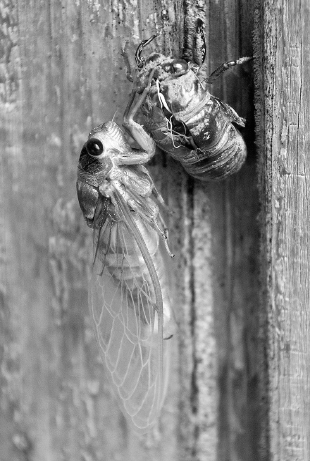Cicadas - Brood for Thought
Tim Iverson
Seasonal Naturalist
Cunningham Falls State Park
 (6/2012) "They’re coming to get you, Barbara! They’ve been (underground) a long time." Although slightly paraphrased it’s still a fairly accurate description of the mood around the upcoming cicada swarm. Brood II cicadas only emerge every 17 years, which means an average person would only be
able to experience the phenomenon about four or five times within their entire lives. While they may swarm into numbers of up to a million per acre in affected areas they pose little threat to the environment, and especially people – well except maybe our ears!
(6/2012) "They’re coming to get you, Barbara! They’ve been (underground) a long time." Although slightly paraphrased it’s still a fairly accurate description of the mood around the upcoming cicada swarm. Brood II cicadas only emerge every 17 years, which means an average person would only be
able to experience the phenomenon about four or five times within their entire lives. While they may swarm into numbers of up to a million per acre in affected areas they pose little threat to the environment, and especially people – well except maybe our ears!
Cicadas are flighted insects that often get grouped in with locusts, but they’d like to let you know they don’t want anything to do with those bad guys of biblical proportions. Cicadas are actually more akin to leaf bugs or even aphids. They belong to a family of insect, Hemiptera, which have a piercing mouth used to suck the sap out of plants and
trees. Their mouths have a sheath-like encasing that retracts between the legs when not in use. When they are using it the sheath extends and contains four needle type proboscises that pierce into plants. They’ll use these like a straw to slurp out the sap.
While they may have the physical ability to fly they are actually miserably poor at it. They also have six legs, but again they aren’t particularly well suited for jumping or running. It’s a wonder they get around anywhere at all really, but then again they don’t really need to. The sheer numbers they swarm in present fairly good odds that much of the
brood will survive predation from birds or other animals. Their impressive numbers aren’t the only thing that keeps away predators though! Their deafeningly loud songs do too! Some cicada species can belt out their ditties at 120 decibels, which is loud enough to permanently damage human hearing if you’re close enough. Some smaller species produces sounds in such high pitches
that humans can’t even hear them. What’s really impressive is that when they are all crooning in unison it actually hurts birds’ ears and disrupts their ability to communicate with one another. By sticking together their chorus can actually reduce predation by birds.
These songs serve another purpose aside from the preservation of life. They also facilitate the procreation of it. What may sound like the shrill cacophony of swarming critters is actually the sweet serenade of love. After cicadas mate the female will lay the eggs into the stem of a plant. Once the eggs hatch they burrow into the ground and spend the
next 17 years growing into maturity by feeding on the sap from plant roots. Once they reach full size the cicada nymphs will dig to the surface, shed their skin, and begin the process all over again.
There’s a lot of noise made over amount of noise cicadas make, and for good reason. I mentioned before that they can produce sounds up to 120 decibels. This is really impressive for such a small insect. However, the cicada produces these love lullabies in a really unique way. Many insects, like crickets, produce sounds by rubbing together different
parts of the body. This is not the case for cicadas. The organ responsible is a ribbed membrane located at the base of the abdomen called a tymbal. These tymbals are contracted inward causing them to buckle and produce sound. Then the cicada relaxes the muscles and the tymbal pops back out and again produce a sound. The sound resonates within the abdomen, which is mostly
hollow, to amplify the sound. Cicadas perform these contractions very rapidly and will alter their body positions to modify the song. Each cicada species have their own particular mating song that females with respond to, allowing for multiple species to coexist together.
Cicadas of this, or any brood for that matter, are also light-heartedly advocated as an appetizer or part of a meal. Just a simple Google search will yield many results for recipes. I’ve seen them described as a mixture of shrimp and asparagus. One blogger even commented, "Don’t think of them as pests, but as flying shrimp, self-delivered and free of
charge." National Geographic publicized that cicadas are low carb, fat free, and gluten free! I’m not planning on being adventurous this go round, but maybe in another 17 years, so I can’t give you any personal recipes or recommendations. It is worth mentioning that cicadas are closely related to lobsters and shellfish, so if you have shellfish allergies use caution.
So, what have we learned so far: Cicadas mating calls could make us deaf, scare away predators, and essentially works like ‘Cicada Mingle’. They live underground for about a 1/5 of our lives feasting on tree root sap only to rise up to the surface once, mate like rabbits, and then drop dead from exhaustion. They make those deafening loud calls by
rapidly sucking in and out hollow parts of their bodies. Finally, they may or may not be better or equal to shrimp cocktail. All in all, whether you like them or not they’re a remarkable little bug, and even if you don’t think they’re very cool at least you have something to brood on.